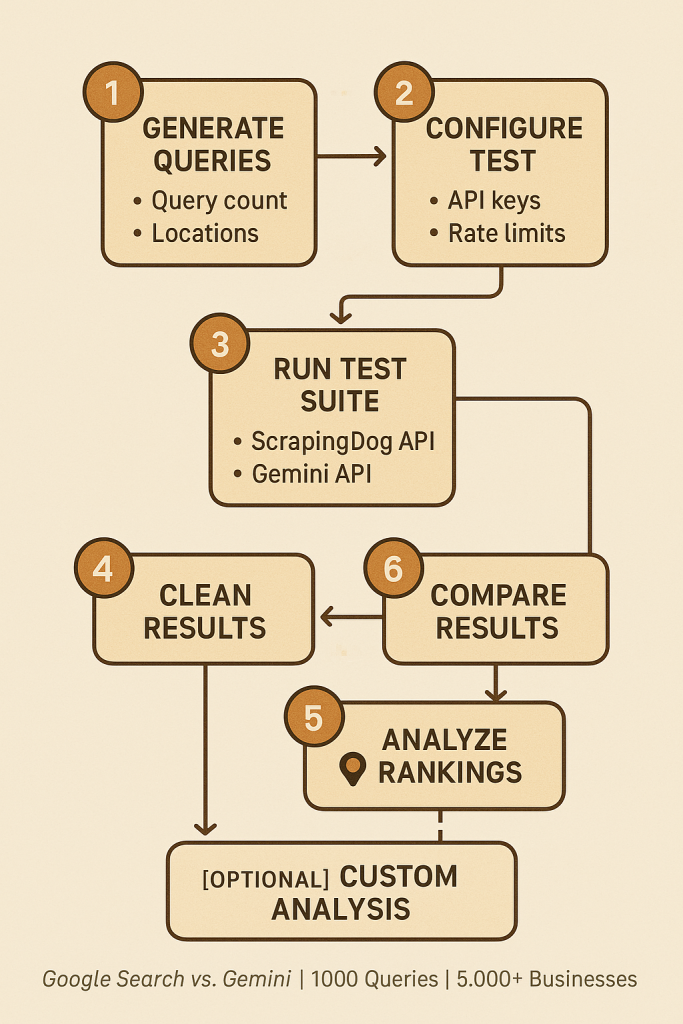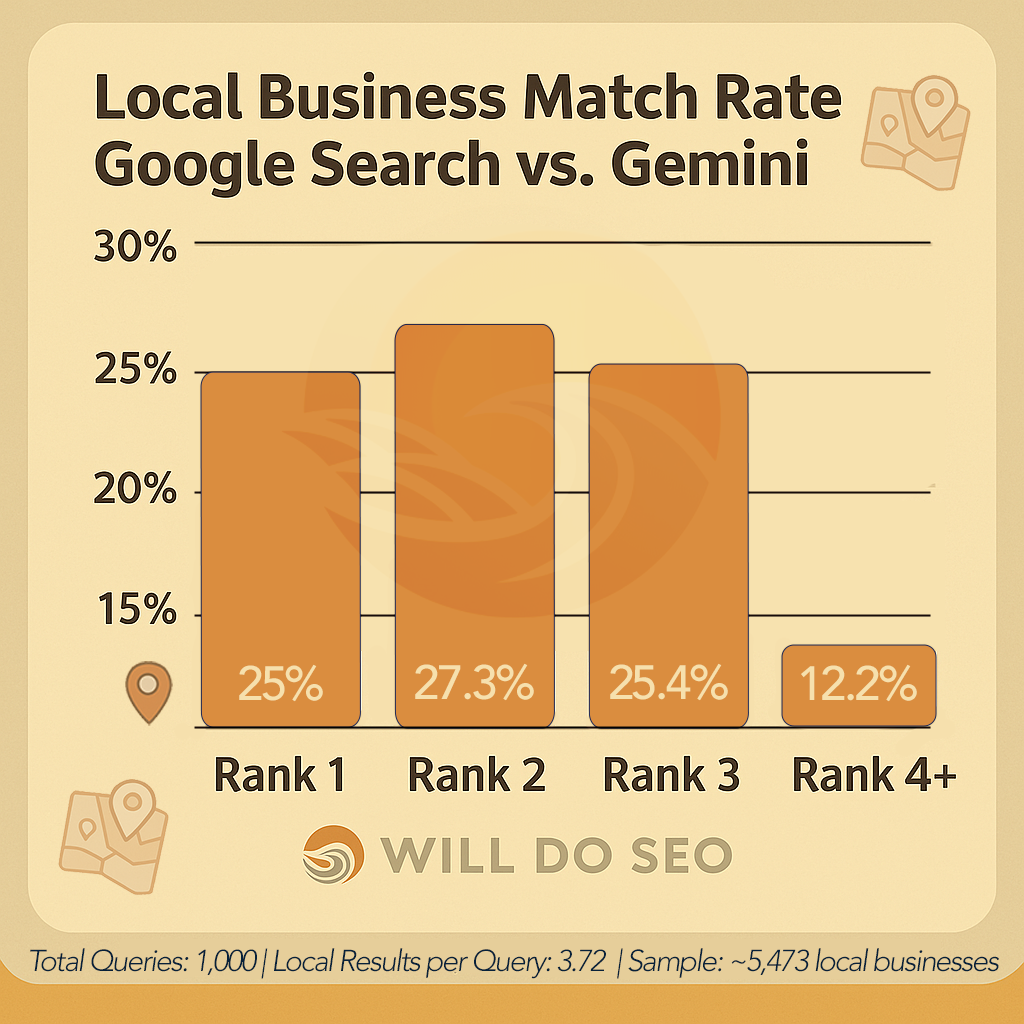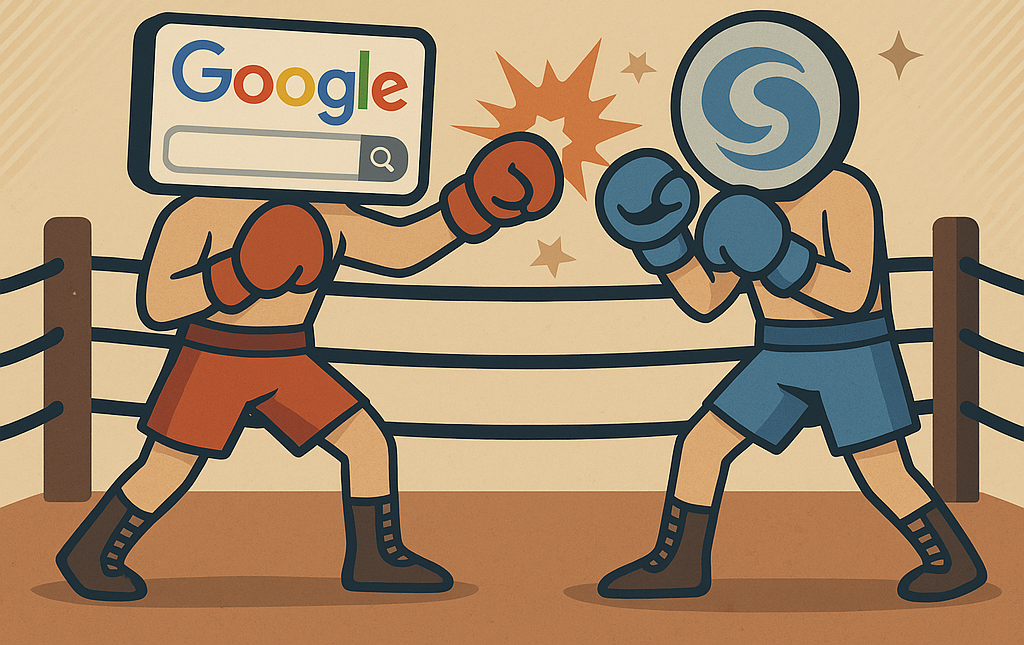Table of Contents
The relationship between traditional search and AI-generated recommendations represents a significant shift in digital discovery. While much discussion remains theoretical, marketers need data to understand how these systems actually behave in practice.
The emergence of AI in search isn’t just another algorithm update—it potentially redefines the fundamental visibility landscape for local businesses across all industries. Understanding the correlation (or lack thereof) between traditional ranking success and AI visibility has profound implications for digital marketing strategy, resource allocation, and competitive positioning.
To address this critical knowledge gap, I conducted a comprehensive analysis comparing how businesses rank in Google’s traditional results versus their appearance in Gemini’s AI responses, focusing specifically on restaurant queries as a representative local business category.
Methodology: How The Data Was Collected

This study examined 1,000 restaurant-related queries, comparing traditional Google Search results retrieved via the ScrapingDog API with AI-generated responses from Gemini-2.0-flash. Data was collected on March 29th, 2025, providing a current snapshot of this rapidly evolving relationship.
For each query, we captured:
- Local Pack results (Google Maps listings)
- Organic search results
- Gemini’s AI-generated responses
Businesses where identified appearing in both traditional results and AI responses, calculating match rates and analyzing patterns across different ranking positions and groups. Statistical significance testing was performed to validate observed differences between ranking groups.
Full post on how this data was collected coming soon!
Local Pack Results: The Strongest Correlation with Statistical Confidence
The analysis of Local Pack results reveals the most compelling correlation between traditional rankings and AI visibility. The data shows remarkably consistent match rates across the top three positions:

| Local Rank | Match Rate | Confidence Interval |
|---|---|---|
| Rank 1 | 25.0% | 22.3% – 27.7% |
| Rank 2 | 27.3% | 24.5% – 30.1% |
| Rank 3 | 25.4% | 22.7% – 28.1% |
When aggregated, businesses in the top three local positions demonstrated a 25.9% likelihood of appearing in Gemini responses (641 matches out of 2,474 businesses). This represents a significant correlation, though it also reveals that approximately three-quarters of top-ranking businesses in traditional local search don’t appear in AI-generated results—suggesting substantial divergence between these discovery systems.
Looking beyond the top positions reveals a fascinating non-linear pattern:
| Local Rank Group | Likelihood | Confidence Interval |
|---|---|---|
| Ranks 1-3 | 25.9% | 24.2% – 27.6% |
| Ranks 4-6 | 5.5% | 4.1% – 6.9% |
| Ranks 7-10 | 22.4% | 19.8% – 25.0% |
| Ranks 11+ | 10.6% | 8.7% – 12.5% |
Statistical testing confirms that this U-shaped pattern is not random chance. The difference between top positions (1-3) and middle positions (4-6) is extremely significant, while interestingly, there is no statistically significant difference between the top positions (1-3) and positions 7-10. This reinforces the unusual U-shaped visibility pattern and suggests complex factors beyond simple rank correlation.
Organic Results: Different Patterns Emerge
The relationship between organic search rankings and AI visibility shows markedly different patterns than local results. The match rates across organic positions are substantially lower than their Local Pack counterparts:
| Organic Rank | Match Rate in Gemini |
|---|---|
| Rank 1 | 6.8% |
| Rank 2 | 2.0% |
| Rank 3 | 6.4% |
In aggregate, only 5.1% of businesses in the top three organic positions appeared in Gemini responses (152 matches out of 2,999 businesses). This represents a nearly 5x difference compared to Local Pack visibility.
The organic rank group analysis reveals relatively flat match rates across positions:
| Organic Rank Group | Total Businesses | Matched in Gemini | Likelihood |
|---|---|---|---|
| Ranks 1-3 | 2,999 | 152 | 5.1% |
| Ranks 4-6 | 3,000 | 143 | 4.8% |
| Ranks 7-10 | 3,996 | 237 | 5.9% |
| Ranks 11+ | 9,485 | 400 | 4.2% |
Local Search Context Influences Organic Result Patterns
The relatively flat match rates across organic positions (ranging from ~4-6%) deserve careful interpretation within the context of this study. Since our analysis focused specifically on restaurant queries—which naturally trigger local intent and location-based results—it’s not surprising that traditional organic rankings showed less correlation with AI recommendations.
This pattern likely reflects the query context rather than a universal principle about organic content relevance. For restaurant searches, Gemini appears to prioritize location-based signals over traditional content authority signals that drive organic rankings. The data suggests that when users search with local intent:
- Location-specific signals may supersede traditional organic ranking factors in AI response generation
- Content that ranks well organically for informational purposes may not necessarily translate to recommendation status for location-based businesses
- The distinct pattern between organic and local results might look quite different for non-local, informational queries

These findings should be interpreted within the specific restaurant category context rather than as a universal statement about organic ranking importance. Different query types (informational, transactional, non-local) might show entirely different correlation patterns between traditional organic rankings and AI visibility.
Combined Results: The Aggregate Picture
When analyzing combined results (merging local and organic rankings), we see a moderated pattern:
| Combined Rank | Match Rate in Gemini |
|---|---|
| Rank 1 | 15.1% |
| Rank 2 | 13.4% |
| Rank 3 | 14.9% |
The combined rank group analysis shows a clearer descending pattern, though still with significant gaps:
| Combined Rank Group | Total Businesses | Matched in Gemini | Likelihood |
|---|---|---|---|
| Ranks 1-3 | 5,473 | 793 | 14.5% |
| Ranks 4-6 | 3,523 | 172 | 4.9% |
| Ranks 7-10 | 4,608 | 374 | 8.1% |
| Ranks 11+ | 9,861 | 440 | 4.5% |
Key Patterns & Marketing Implications

1. The Local Pack Advantage Is Real and Statistically Validated
The dramatic difference between local pack match rates (25.9%) and organic match rates (5.1%) suggests that Google’s AI prioritizes signals closely associated with local relevance. This finding has significant implications for marketing strategy and budget allocation:
- Local signals like proximity, relevance, and prominence appear to influence AI recommendations far more than traditional organic ranking factors
- Marketing investments in Google Business Profile optimization and local citation management may yield dividends across both traditional and AI-driven discovery
- The ROI calculation for local SEO potentially increases when considering its dual impact on both discovery channels
The statistical validation of these differences removes any doubt that they could be attributed to random chance or sampling errors.
2. The U-Shaped Local Results Pattern Challenges Conventional Wisdom
The peculiar pattern where positions 4-6 (5.5%) have significantly lower match rates than both top 3 (25.9%) and positions 7-10 (22.4%) suggests more complex dynamics than simple rank correlation. Statistical testing confirms this is a genuine pattern, with no significant difference between positions 1-3 and 7-10, but extreme significance in the drop for positions 4-6.
Several hypotheses might explain this pattern:
- Presentation bias in the traditional interface may influence AI training data
- Algorithmic differences in how businesses are evaluated for positions 4-10 versus top positions
- Potential data artifacts related to how businesses in these middle positions are represented
Why This Research Matters
This analysis represents early exploration of how traditional search visibility correlates with AI-generated recommendations. As marketers navigate the transition to an increasingly AI-mediated discovery landscape, understanding these relationships becomes essential for:
- Strategic planning and resource allocation
- Competitive positioning and differentiation
- Performance measurement and benchmarking
- Adaptation to the emerging dual-audience reality
Limitations
This analysis provides a valuable snapshot of current relationships between traditional search and AI discovery, but several limitations should be noted:
- The data reflects a single point in time (March 29th, 2025) in a rapidly evolving landscape
- The focus on restaurant queries may not generalize perfectly to all business categories
- The patterns observed may reflect both algorithmic design and training data influence
WillDoSEO.com

